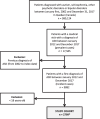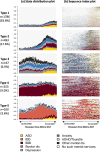Pathways to autism diagnosis in adulthood
- PMID: 40596839
- PMCID: PMC12217371
- DOI: 10.1186/s11689-025-09627-3
Pathways to autism diagnosis in adulthood
Abstract
Background: This study explored Trajectories of Diagnoses (TDs) preceding a first diagnosis of autism in adulthood.
Methods: This retrospective cohort study used health administrative data from Quebec, Canada, and included all adults with a first recorded diagnosis of autism between 2012 and 2017. A TDs was defined as a succession of medical records of psychiatric and/or neurodevelopmental conditions over time. These TDs were retrospectively analyzed from 2002 to 2017, using a state sequence analysis of diagnoses, in order: Autism, Intellectual or developmental disabilities (IDDs), Schizophrenia spectrum disorder (SSD), Bipolar Disorder (BD), Depressive Disorder (DD), Anxiety Disorder (AD), Attention-deficit/hyperactivity disorder (ADHD), and Other psychiatric and/or neurodevelopmental conditions.
Results: The cohort included 2799 adults with a first recorded diagnosis of autism between 2012 and 2017. Several psychiatric and/or neurodevelopmental conditions were recorded since 2002, including AD (77.5%), DD (58.0%), SSD (49.4%), BD (48.3%), and IDDs (33.2%). Results revealed 5 distinct types of TDs. Types 1 (63.8%), 2 (17.6%) and 3 (6%) represented individuals in younger age groups with similar characteristics but with very different sequences of diagnoses, characterized by mixed diagnoses in type 1, SSD and AD in Type 2, and IDDs, DD, AD, and ADHD in type 3. Types 4 and 5 (9.0% and 3.6%), representing middle-aged/older groups, displayed distinctive TDs associated with high healthcare use, almost entirely associated with SSD (Type 4) and BD (Type 5).
Conclusion: This study proposes a complementary examination of the multiple pathways to diagnosis experienced by adults, highlighting the need to address differential diagnosis and co-occurring psychiatric and neurodevelopmental conditions.
Keywords: Autism spectrum disorder; Healthcare use; Mental healthcare; Neurodevelopmental disorder; Psychiatric disorder; State sequence analysis.
© 2025. The Author(s).
Conflict of interest statement
Declarations. Ethics approval and consent to participate: This study was approved by the Research Ethics Board Committee of the Université de Sherbrooke and by the Commission d'accès à l'information of Quebec. Competing interests: The authors declare no competing interests.
Figures



References
-
- Lewis LF. Identifying autism spectrum disorder in undiagnosed adults. Nurse Pract. 2018;43:14–8. - PubMed
-
- Lord C, Elsabbagh M, Baird G, Veenstra-Vanderweele J. Autism spectrum disorder. Lancet. 2018;392:508. Available from: https://pmc.ncbi.nlm.nih.gov/pmc/articles/PMC7398158/. [cited 2023 Dec 21]. - PMC - PubMed
-
- Rosen NE, Lord C, Volkmar FR. The Diagnosis of Autism: From Kanner to DSM-III to DSM-5 and Beyond. J Autism Dev Disord. 2021;51:4253–70. Available from: https://link.springer.com/article/10.1007/s10803-021-04904-1. [cited 2024 Jan 13]. - DOI - PMC - PubMed
-
- Fusar-Poli L, Brondino N, Politi P, Aguglia E. Missed diagnoses and misdiagnoses of adults with autism spectrum disorder. Eur Arch Psychiatry Clin Neurosci. 2022;272:187–98. Available from: https://pubmed.ncbi.nlm.nih.gov/32892291/. [cited 2023 Dec 5]. - PMC - PubMed
-
- Zeidan J, Fombonne E, Scorah J, Ibrahim A, Durkin MS, Saxena S, et al. Global prevalence of autism: A systematic review update. Autism Res. 2022;15:778–90. Available from: https://onlinelibrary.wiley.com/doi/full/10.1002/aur.2696. [cited 2023 Dec 20]. - DOI - PMC - PubMed
MeSH terms
LinkOut - more resources
Full Text Sources

